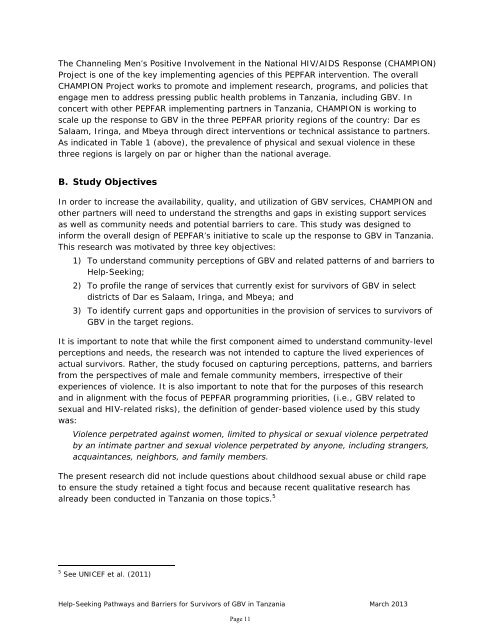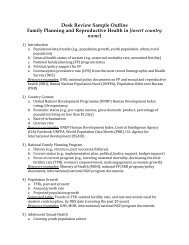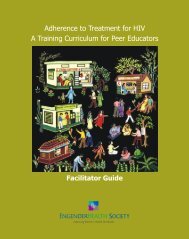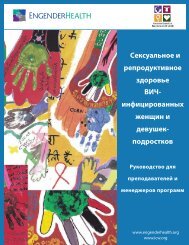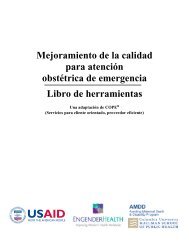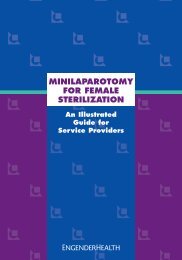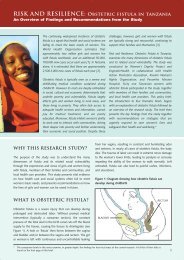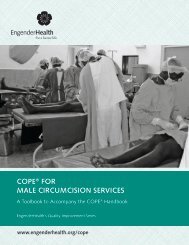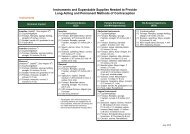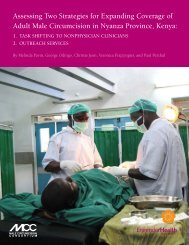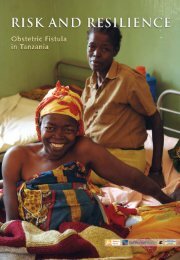Help-Seeking Pathways and Barriers for ... - EngenderHealth
Help-Seeking Pathways and Barriers for ... - EngenderHealth
Help-Seeking Pathways and Barriers for ... - EngenderHealth
Create successful ePaper yourself
Turn your PDF publications into a flip-book with our unique Google optimized e-Paper software.
The Channeling Men’s Positive Involvement in the National HIV/AIDS Response (CHAMPION)<br />
Project is one of the key implementing agencies of this PEPFAR intervention. The overall<br />
CHAMPION Project works to promote <strong>and</strong> implement research, programs, <strong>and</strong> policies that<br />
engage men to address pressing public health problems in Tanzania, including GBV. In<br />
concert with other PEPFAR implementing partners in Tanzania, CHAMPION is working to<br />
scale up the response to GBV in the three PEPFAR priority regions of the country: Dar es<br />
Salaam, Iringa, <strong>and</strong> Mbeya through direct interventions or technical assistance to partners.<br />
As indicated in Table 1 (above), the prevalence of physical <strong>and</strong> sexual violence in these<br />
three regions is largely on par or higher than the national average.<br />
B. Study Objectives<br />
In order to increase the availability, quality, <strong>and</strong> utilization of GBV services, CHAMPION <strong>and</strong><br />
other partners will need to underst<strong>and</strong> the strengths <strong>and</strong> gaps in existing support services<br />
as well as community needs <strong>and</strong> potential barriers to care. This study was designed to<br />
in<strong>for</strong>m the overall design of PEPFAR’s initiative to scale up the response to GBV in Tanzania.<br />
This research was motivated by three key objectives:<br />
1) To underst<strong>and</strong> community perceptions of GBV <strong>and</strong> related patterns of <strong>and</strong> barriers to<br />
<strong>Help</strong>-<strong>Seeking</strong>;<br />
2) To profile the range of services that currently exist <strong>for</strong> survivors of GBV in select<br />
districts of Dar es Salaam, Iringa, <strong>and</strong> Mbeya; <strong>and</strong><br />
3) To identify current gaps <strong>and</strong> opportunities in the provision of services to survivors of<br />
GBV in the target regions.<br />
It is important to note that while the first component aimed to underst<strong>and</strong> community-level<br />
perceptions <strong>and</strong> needs, the research was not intended to capture the lived experiences of<br />
actual survivors. Rather, the study focused on capturing perceptions, patterns, <strong>and</strong> barriers<br />
from the perspectives of male <strong>and</strong> female community members, irrespective of their<br />
experiences of violence. It is also important to note that <strong>for</strong> the purposes of this research<br />
<strong>and</strong> in alignment with the focus of PEPFAR programming priorities, (i.e., GBV related to<br />
sexual <strong>and</strong> HIV-related risks), the definition of gender-based violence used by this study<br />
was:<br />
Violence perpetrated against women, limited to physical or sexual violence perpetrated<br />
by an intimate partner <strong>and</strong> sexual violence perpetrated by anyone, including strangers,<br />
acquaintances, neighbors, <strong>and</strong> family members.<br />
The present research did not include questions about childhood sexual abuse or child rape<br />
to ensure the study retained a tight focus <strong>and</strong> because recent qualitative research has<br />
already been conducted in Tanzania on those topics. 5<br />
5 See UNICEF et al. (2011)<br />
<strong>Help</strong>-<strong>Seeking</strong> <strong>Pathways</strong> <strong>and</strong> <strong>Barriers</strong> <strong>for</strong> Survivors of GBV in Tanzania March 2013<br />
Page 11


